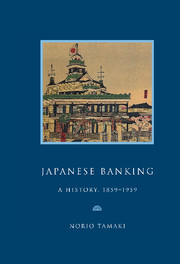Book contents
- Frontmatter
- Contents
- Preface
- Genealogy of leading Japanese banks, 1859–1959
- List of abbreviations
- Map
- Part I A bankrupt Shogunate, 1859–1868
- Part II The Meiji Restoration: monetary confusion and banking experiments, 1868–1881
- Part III Matsukata, the wizard of Japanese banking, 1881–1897; the Yokohama Specie Bank (1880) and the Bank of Japan (1882)
- Part IV The Japanese on the London money market, 1897–1911
- Historical background
- 13 The ‘Siamese twins’: Nichigin and Shokin, 1897–1911
- 14 Special banking, 1897–1911
- 15 Banking at the end of the Meiji era, 1900–1911
- 16 Banking and the securities market, 1897–1911
- Part V War, the Japanese boom years, 1911–1919
- Part VI Crisis and the road to war, 1919–1937
- Part VII Complete commitment, struggle and defeat, 1937–1945
- Part VIII American ‘democratisation’ and the search for growth, 1945–1959
- An extraordinary century, 1859–1959
- Appendices
- Notes
- Bibliography
- Index
16 - Banking and the securities market, 1897–1911
Published online by Cambridge University Press: 03 February 2010
- Frontmatter
- Contents
- Preface
- Genealogy of leading Japanese banks, 1859–1959
- List of abbreviations
- Map
- Part I A bankrupt Shogunate, 1859–1868
- Part II The Meiji Restoration: monetary confusion and banking experiments, 1868–1881
- Part III Matsukata, the wizard of Japanese banking, 1881–1897; the Yokohama Specie Bank (1880) and the Bank of Japan (1882)
- Part IV The Japanese on the London money market, 1897–1911
- Historical background
- 13 The ‘Siamese twins’: Nichigin and Shokin, 1897–1911
- 14 Special banking, 1897–1911
- 15 Banking at the end of the Meiji era, 1900–1911
- 16 Banking and the securities market, 1897–1911
- Part V War, the Japanese boom years, 1911–1919
- Part VI Crisis and the road to war, 1919–1937
- Part VII Complete commitment, struggle and defeat, 1937–1945
- Part VIII American ‘democratisation’ and the search for growth, 1945–1959
- An extraordinary century, 1859–1959
- Appendices
- Notes
- Bibliography
- Index
Summary
There were forty-six stock exchanges by 1898; the first founded in Tokyo and Osaka in 1878. Thereafter numbers dropped and, by 1911, there were stock exchanges at Tokyo, Osaka, Yokohama, Kobe, Kyoto, Nagoya, Niigata, Nagaoka, Hakata (Fukuoka), Kuwana (Aichi), Wakayama, Hiroshima and Nagasaki, making thirteen in all. During the company promotion and general economic boom in the late 1890s, in the aftermath of the Sino-Japanese War, the Ministry of Finance encouraged provincial businessmen to establish their own stock exchanges. Inevitably the mushrooming of stock exchanges led to speculation and abuse.
During this company promotion boom period there were very few listed company stocks, particularly in provincial stock exchanges. The favourite securities became therefore the shares and stocks of their own joint-stock stock exchange institutions which were joint-stock companies themselves and which share listings were peculiarly Japanese. Tokyo Stock Exchange carried on the same sort of business. Additionally, the stock exchanges were also allowed to deal in rice futures, which became favourite targets for speculation. From 1902 to 1906, the government, while encouraging transactions of the many national bonds, was eager to suppress small provincial stock exchanges. By 1911, as we have seen, nearly three-quarters of the stock exchanges had disappeared.
Despite its fragile foundation the securities market in Tokyo and Osaka grew steadily. From 1897 to 1911, the aggregate value of listed stocks and shares in Tokyo soared from ¥564 million to ¥2,095 million, roughly the same sum as the total banking advances. But during this brief period Osaka lost its supremacy.
- Type
- Chapter
- Information
- Japanese BankingA History, 1859–1959, pp. 108 - 110Publisher: Cambridge University PressPrint publication year: 1995



